Read More: https://www.xproducts.com/can-cannon-soda-can-launcher-ar-15-m16
The original Can Cannon review remains the most fun I’ve ever had with a firearm. The concept is simple enough. Knock the upper off your AR-15 and slap on a Can Cannon. Find some .223 or 5.56 blanks, a bunch of full cans of your favorite carbonated beverage (or tennis balls, or whatever will fit) and get ready for a good time.
[full_width]
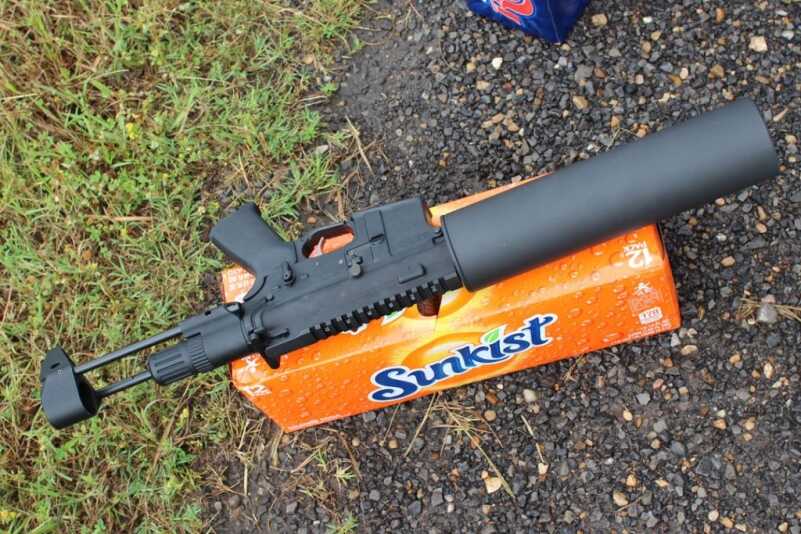
This is not a Sunkist plug, but the orange cans show up nicely on a cloudy sky.
[/full_width]
Since the original review, I’ve gotten rather proficient with this beast. I have a growing list of brands and flavors of soda that work (and another list of those that pop into a messy spray of fizz the moment you pull the trigger). I’ve got pretty good aim with tennis balls. I’ve even developed a decent system for teaching people how to shoot the cans that the Can Cannon shoots with shotguns–and the challange and spectacle of popping open cans of Coke with a 12 gauge beats the pants of of the old clay pigeon.
I am truly a Can Cannon fan. And I’m not alone. I’ve had people who are normally not “gun” people ask me how they can get a Can Cannon. So–if the Can Cannon is so much fun, and capable of winning so many converts–why is it that the BATFE decided that the Can Cannon needed further scrutiny?

The Can Cannon shoots just about anything that will fit down this tube, including their new grappling hook–so you can imagine how the BATFE would want to consider their opinions carefully.
What didn’t the ATF like?
Those of us who move in the gun industry have a healthy respect for the rules and regulations and opinions of the BATFE. Even if we disagree with their findings, many of our livelihoods depend on compliance. So it was with a heavy heart that I learned that the BATFE had changed course and decided the first production version of the Can Cannon could be considered dangerous.
Of course it can be destructive. Just about anything can be dangerous or destructive if you don’t use it correctly. But “just about anything” doesn’t fall under the regulatory scrutiny of the BATFE. So air-powered t-shirt launching cannons, or pumpkin-chuckers, or a trebuchet capable of hurling a Volkswagen half a mile… just as destructive. Perhaps more destructive. But they don’t involve firearms, so they’re exempt.
The Can Cannon requires a firearm to operate. The upper fits an AR lower, and that opens Pandora’s box. And the Can Cannon requires a blank cartridge to be really impressive (otherwise it is just a big tube). And it is this combination that came under scrutiny.
The smooth-bore tube on the Can Cannon is like a barrel, so the ATF began looking at it as a barrel. As it isn’t 18 inches long, which is the short end for typical shotguns, the Can Cannon was–according to the BATFE–a short barreled shotgun (when attached to an AR with a stock) or, potentially, an Any-Other-Weapon (if attached to a dedicated pistol receiver).
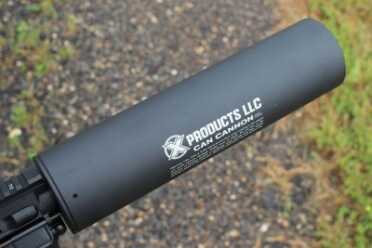
The tube, which is not a barrel, exactly, is not long enough to be a shotgun–technically speaking.
All of that may seem confusing enough, but there’s more. The Can Cannon has a small section of actual barrel inside this large tube. So is that the barrel, or is the large tube the barrel? They can’t both be barrels. And the small one (that holds the blank round and vents the gas) is specifically designed so that it can’t fire a round. The tube is designed to launch an object. The BATFE uses some alternate words to talk about this portion of the Can Cannon, calling it a “cup-type device,” but noting that it has a “smooth bore.”
In short, what the Can Cannon was and what it could possibly do became murky. So X-Products had to make some obvious clarifications and permanent modifications.
There seemed to be one other fear that kept cropping up. As the Can Cannon is built around a section of heavily modified barrel, the BATFE feared that someone could use the device to fire live rounds. Either intentionally or accidentally, the result of firing a round through the device would be catastrophic. So X Products had to consider this option, too.
They could:
- Add (more) holes after the chamber so that all of the gasses are expelled instantly, which could prevent a projectile from being fired from the short barrel section. Maybe.
- Add (more) holes after the chamber and weld a plug/plate over the bore so that no projectile can pass through.
- Make the tube 18” long, and therefore meet the length requirement for a shotgun–even though that option didn’t really seem logical.
- Make the tube 16.5″ and rifle the inside of the tube, making it a rifle.
[one_half]

Gas vents though this ported gas-tube type extension on the chamber.
[/one_half][one_half_last]

The original tube is blocked on this end. This small detail would make shooting a live round dangerous/deadly.
[/one_half_last]
How did X-Products address this?
If you were only shooting tennis balls, a slow twist might do a lot for the sustained accuracy. I doubt it wold get a Coke can to spin. But they passed on that option.
And they didn’t lengthen the tube. Doing so would mean a huge burden for replacing the existing short tubes on all of the original Can Cannons that they sold.
I can see evidence of welding at the end of the vented section of barrel inside the fat tube. That would prevent anyone from removing the plug and trying to shoot .223 from it. They have also welded a steel bar inside the chamber that will prevent you from accidentally cambering a .223 round.
[one_half]
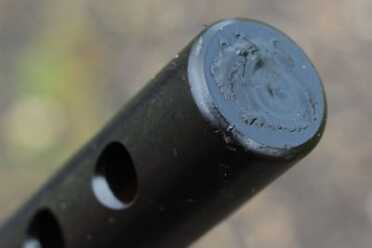
The new tip is welded closed.
[/one_half][one_half_last]

The holes are still the same. Note the welded pin to prevent live rounds from chambering.
[/one_half_last]
At the end of the process, they resubmitted a sample and the BATFE gave them a letter saying that the Can Cannon is good-to-go. That is, of course, a paraphrase. If you want to dive into all of the very compelling BATFE language, I’d suggest reading a copy of the BATFE approval letter: https://www.xproducts.com/sites/default/files/docs/Final-Approval-BATF-Can-Cannon.pdf.
If you happen to have an older Can Cannon, it is time to get it back to X-Products. Actually this piece is all they need. You’ll pay shipping to them, they’ll cover shipping back to you. The rest of the upper, and the tube, is the same.
The Grappling Hook
This is why you’re here, right? The BATFE is engaging and all, but bring on the grappling. So how exactly does the grappling hook work? Turns out it isn’t as complex as you might think–only I bet there was a lot of design work to make it look this simple.
[full_width]
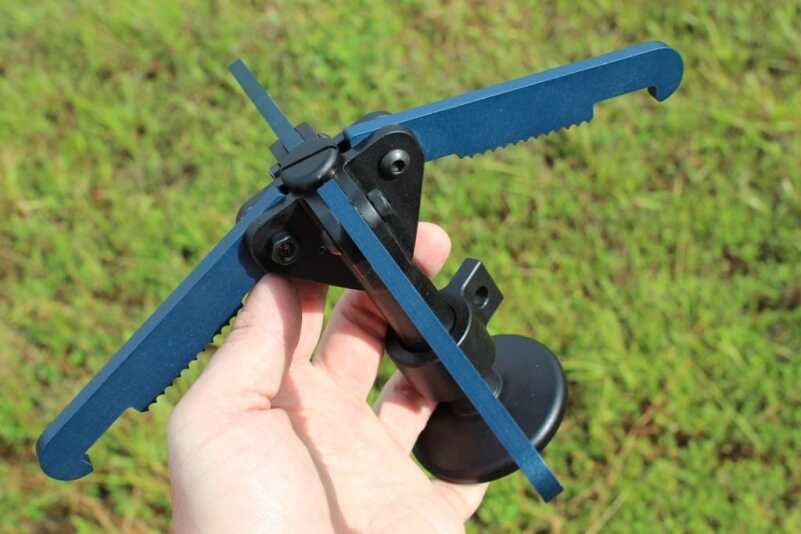
Th grappling hook.
[/full_width]
To begin with, the device is built around an aluminum core. That holds the arms on one end, and has a Coke-can shaped butt on the other. The arms are spring loaded. Fold them in and insert them into the Can Cannon. Simple as that–unless you want the grappling hook back after you shoot it.
In that case, you’ll need to tie a rope around the floating collar that is secured around the center shaft. This rope would then feed out of the muzzle end of the Can Cannon.
[one_half]
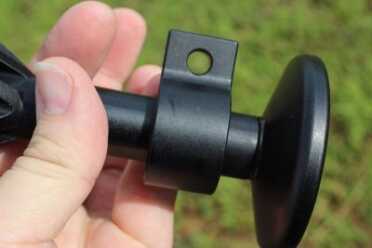
The collar.
[/one_half][one_half_last]
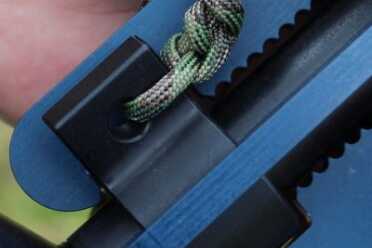
Tie off here so you can get the hook back.
[/one_half_last]
While it would be nice if you could load the rope into the Can Canon, so the whole unit would be contained, you could run into difficulties. For one, the rope would have to be almost indestructible to avoid burning or melting from the heat of the gases. The second concern, which exists for all applications, concerns the rope getting bound up. If you shoot the grappling hook on a short rope–or a bound or knotted rope–it could just reach the end of the available length and fall like a yo-yo that doesn’t come back. Or it has the potential to pendulum. I’m thinking here of those disastrous attempts to link two cannon balls together with a chain. The idea was two cannons could fire linked shot down a battlefield and mow an army down. The reality was that one cannon almost always went off first, and that ball would swing out in an arc and take out one or both cannon crews. Then the other cannon might fire.
[one_half]
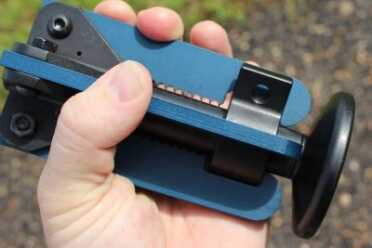
Compact the arms.
[/one_half][one_half_last]

Slide it in.
[/one_half_last]
The grappling hook attachment doesn’t need to be any more dangerous than a typical Coke can, but I’d still suggest you think through your rope issues early. Make sure you’re not wrapped around your own leg, or bound up, etc.
So what’s the grappling hook good for?
Well, 9 year old boys find it very impressive. They’re the first group I’d ask for a list. There are some grown-up applications, too. The grappling hook could be useful for spanning distances. If you need a lead line across a chasm of some sort. Or you may find some nautical applications. I’ve heard the Coast Guard is actually looking into the technology for use when securing small craft. Shoot the hook onto a boat, secure a line, haul it in.
I’m having a hard time thinking of something I’ve done, ever, that might have been easier with this device. Perhaps hanging bear-bags. I used to hike, a lot, in an area where there were occasional steel cables strung high between trees. I’ve spent too much time trying to throw a rope (usually tied to a rock) over the line to haul up food and smellables. But hiking with the Can Cannon, just for this purpose, may not be practical.
I’ll let you know when I nail it down.
[one_half]
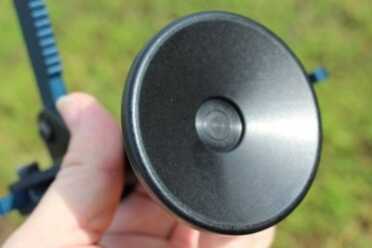
The back end is cupped like the bottom of a can and keeps the gasses off the rope.
[/one_half][one_half_last]
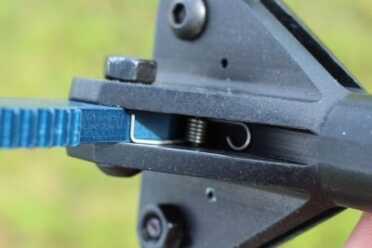
The arms are spring loaded.
[/one_half_last]
We tested the range to the best of our abilities. The hook, when pulling basic para-cord, will go as far as 175 feet when shot at a modest arc. In fact, as the video suggests, the Can Cannon shoots a can, and grappling hook, and even a tennis ball about the same distance. We had great luck testing the aim with tennis balls before experimenting with the grappling hook. The hook will hit about the same place the ball will take its first bounce when the Can Cannon is aimed at a similar angle.
The hook will go up at least 150 feet if fired vertically. This presents some logical complications to the shooter, as it may well come down if you miss your target.

When the line stretches, the hook wants to bounce back, which can result in a tangle.
Grappling problems?
Here are a couple of lessons we learned. The first should be obvious to anyone who has ever dealt with rope. Para-cord has a stretch factor. If you secure a 100 foot length at one end, and stand 100 feet away, the grappling hook can still reach you. And once that cord has stretched out, it will want to come back a ways, so it may get you twice. Don’t stand within range of the grappling hook.
The second has to do with the grappling action itself. The Grappling hook, once it lands, wants to tumble a bit, and it can wrap itself up in the cord, which can prevent it from working.
After banging the grappling hook around for a while, we did manage to ding up one arm so that it didn’t open and close reliably. A bit of sand paper solved that problem just fine. We’d roughed up the area where both connect, as you can see in the video–but it was nothing major.
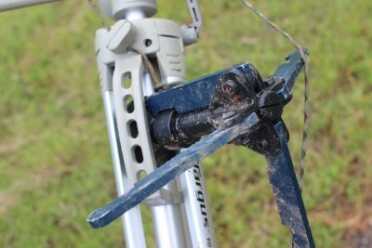
You can see here how the one arm hasn’t extended.
The last note I’ll make is about how hard it is to actually grapple. We could could get the hook right where we wanted it, but still not manage to secure the grappling hook. Trees were the obvious exception. After several attempts with the Can Cannon and a steel cattle gate, we moved onto smaller objects. If you watch the video above, you’ll see that I did manage to hook the camera tripod. It took a number of shots to get it right, but that’s because we didn’t want to kill the camera, just hook it.
The message here is that this is a viable tool, but you will have to practice with it.
Other Can Cannon devices coming?
They’re still working on a duck decoy for dog training. This will help them learn to fetch at greater distances, and help acclimate them to gunfire. They’re also working on a net launcher for knocking down drones and a t-shirt launcher.
How does it compare to the original?
This is the crux of the biscuit for me. The first Can Cannon put up some impressive numbers. It isn’t possible to predict exactly how far or how fast every can will go. And tennis balls are even more finicky, as the fit changes with every shot. As the fuzz burns from the outside of the ball, the gases have more room to escape and velocity and distance decrease.
The new Can Cannon seems to have no decrease in performance. I wouldn’t expect it to, really. The system, though redesigned, is still fundamentally the same. The biggest variable will be the blanks. Some of the ones we shot were a bit under-powered. Balls and cans would pop out, but not with the typical oomph. And then we would have the occasional round that would kill it. When you are running the grappling hook, this would also kill your shoulder.
But don’t let that stop you. I pulled the trigger at least 50 times yesterday, and my right arm is a bit numb today. But it is worth it, even if I can’t seem to find the right keys with my tingling fingers.
If you haven’t had the chance to pull the trigger on one of these, I’d suggest you find one.
[full_width]
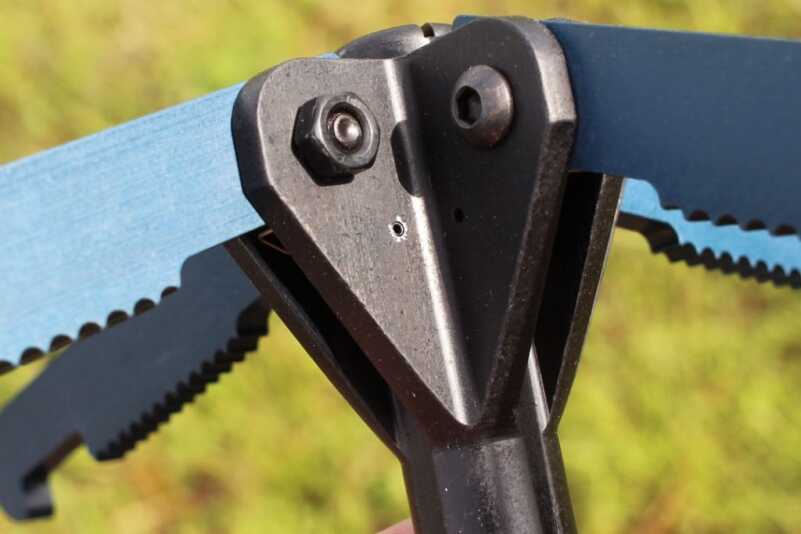
The arms are bolted in.
[/full_width][one_half]

Inserted in the can, it fits flush. Note the cord sticking out.
[/one_half][one_half_last]
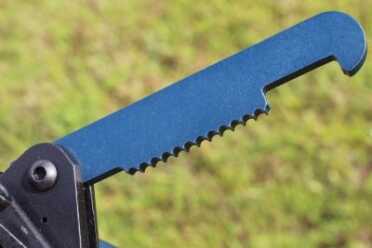
The arms are serrated.
[/one_half_last]
[full_width]
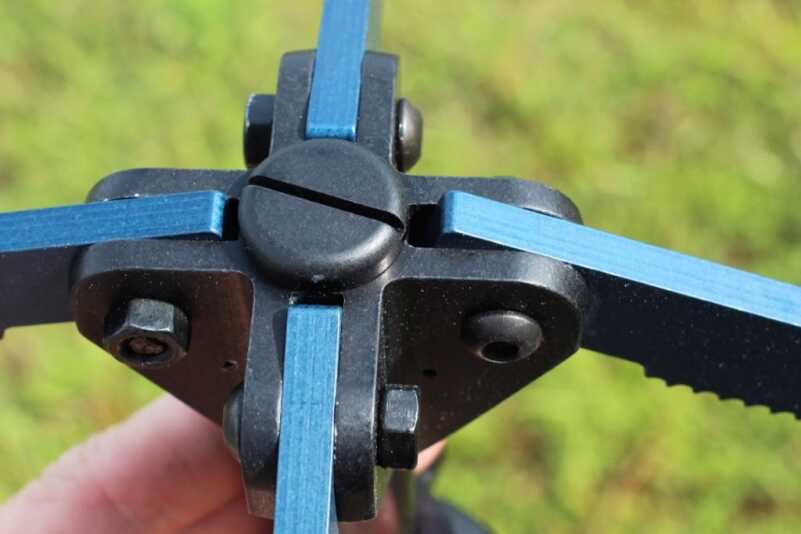
From the top.
[/full_width][one_half]
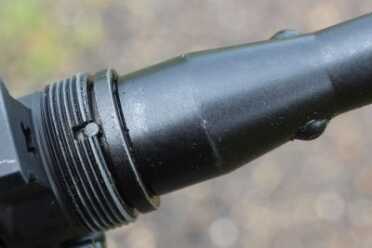
The gas vent is based on a modified AR barrel.
[/one_half][one_half_last]
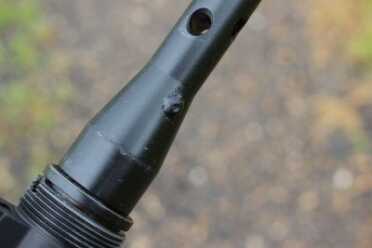
And it is pinned so a live 5.56 round won’t chamber.
[/one_half_last][full_width]
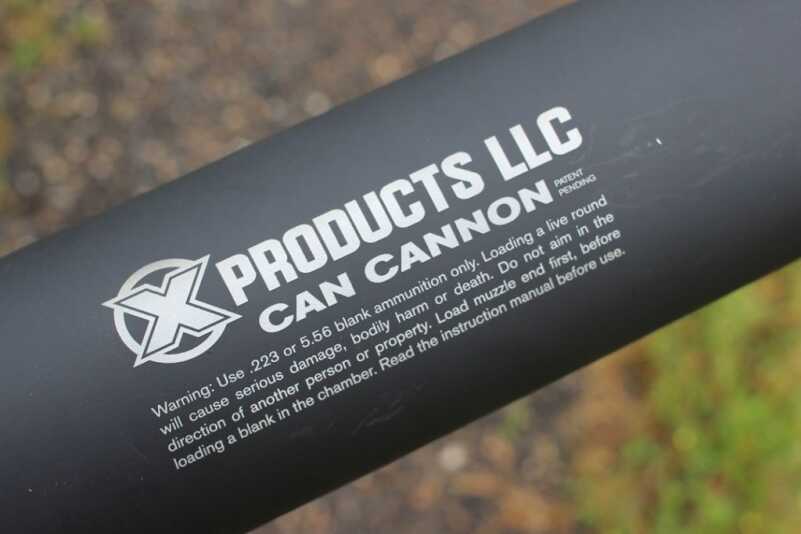
X Products.
[/full_width]
[full_width]
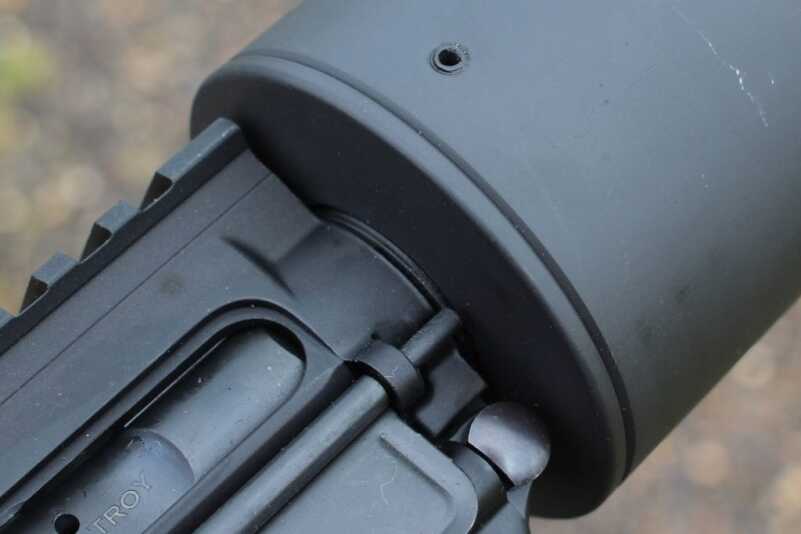
The outer tube screws onto the upper.
[/full_width]

I assisted the XProducts company in designing a grappling hook for the Can Cannon. The late Marine EOD Sgt. David Lyon used small grappling hooks of his own manufacture to yank clear trip lines and plow up firing wires from over 300 IEDs in Iraq. Note non-sparking limbs, blunt tips and the ability to attach 1,000 pound test Kevlar line to the unit. There are other Marine and even Urban Combat Climbing applications, but every time you fire one for fun, think of Dave…he was a Hero, capital “H”. Before he died he taught us many things, but the hardest one was that War does not always kill you right away.
The people who killed Lyon of Ramadi need to remember that…
Dump the idiotic background music.
The design of that grappling hook looks cool and all, but it would be terrible for actually getting it to actually grapple onto something. Those things are too straight to reliably hook onto something. I like the concept though. Maybe if they didn’t open so far they would hook onto things better.
Pro Tips: 1, if you get IMI manufactured blanks, they have a stronger load than Lake City blanks, or commercial 223 blanks, ergo you get better range, albeit with more kick.
2. If you wipe your cans down with a paper towel sprayed with cooking spray (Pam, etc), you will get more range. Also, if you are using IMI blanks, that’s the only way to keep the cans from rupturing right out of the barrel.
ask me how i know. 😉
can”t wait to get my replacement part, or for them to release the AR-10 version, which is due out soon, at about the same price point as the oiriginal, according to the folks i’ve talked to at X-Products.
during ww2 the rangers had grappling system worked with mortor tube 60 mm I think and it worked quit well on Normandy beaches adapt and over come.
Ben Taul
Merna Ne.
Hey man. If you want to get more use out of your tennis balls wrap them in aluminum foil before you launch them. Also, you can adjust the launch pressure by adding layers of foil.
It would be a great help in hiding stashes of food, ammo, or other gear high into the crown of trees. Getting a line 60 feet up into the crown of a pine has befuddled me lately. This could be the solution of my problem.
This is a pretty cool gadget. For the grappling hook the only suggestion to make it hold onto something is to angle the arms in and not straight out. Thanks for the review. You didn’t mention the price or maybe I didn’t see it.
Thanks again,
Ruben Cordova
USN Retired
I own a can and am waiting on the net to use hunting feral hogs here in Texas. You’re welcome to come on down to try it!
Why not a “comet” shaped rubber throwing weight? I used to see the ship crews throw these weights to the longshoremen with a smaller rope or cord to start the three-inch lines to tie up ships to the docks.
I also saw seamen using a pop-gun like device to send weights to shore to start one-inch lexan lines to tie US aircraft carriers to the docks in the in the early 90’s.
The Navy line throwing gun you are talking about uses a .45 cartridge. It has a piston in the barrel with the line outside. The first section is orange cordage then large line until the mooring line or the high wire reaches the ship or pier. The Navy has been using them for many years. The “comet” you’re talking about is a “Monkey Fist” tied around a weight and is swung in a overhead circle then thrown to the pier this is called the heaving line. USN 69-78
Sabot. Nuff said.
What do you think about removing the teeth and creating a hook and tip same as the original grappling hook used by the Road Runner to snare the Coyote? m
My wife tells me I’m like a little kid on an adventure… it’s true, I’m immature in my retirement and love being 9 years old and actually doing everything that comes to mind, but no single point of failure.
Will, what do think about making the shaft of the hook longer? It would protrude from the end of the tube, but not enough to allow the hooks to deploy. Then the pivot point would be smaller in relation to the overall length and have less effect. OR have two lines attached to the hook on opposing sides that would join into one line short of the tube length. God forbid anything get hooked onto the loop. But it would reduce (not eliminate) unilateral pull through the air. Four would eliminate it, but I could see that getting ugly. I have no experience what so ever with grappling hooks. But a few decades ago I was pretty good in geometry.
They could probably get more distance and accuracy if the line was attached to a trigger which released the springload for the arms. Then it would fly more as a cylinder until the line was taut.
The reason it does not work. I’ve toss a few grappling hook/lines and if you got them over the top ot the target they would grab as long at tension was maintained. The problem with the design shown is the base. Its shape it to allow it to be fired by resisting and holding gass pressure. It does that well. What it also does is act like a pivot point when line tension is applied. The base engages what would be an adequate anchor point, but then flips the tines (hooks) away and over the anchor point. A cone shape base would allow the base to slide over the anchor point without pivoting the tines away from it. No charge. Lol